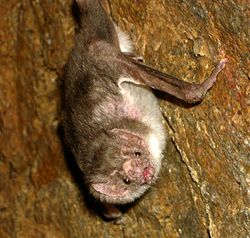Vampire bat
2008/9 Schools Wikipedia Selection. Related subjects: Mammals
| The Vampire Bat | ||||||||||||
|---|---|---|---|---|---|---|---|---|---|---|---|---|
 Common Vampire Bat, Desmodus rotundus
|
||||||||||||
| Scientific classification | ||||||||||||
|
||||||||||||
| Genera | ||||||||||||
|
Desmodus |
Vampire bats are bats that feed on blood ( hematophagy). There are only three bat species that feed on blood: The Common Vampire Bat (Desmodus rotundus), the Hairy-legged Vampire Bat (Diphylla ecaudata), and the White-winged Vampire Bat (Diaemus youngi). All three species are native to the Americas, ranging from Mexico to Brazil, Chile, and Argentina. The Vampire Bat is known to feed on horses, donkeys, pigs, goats, and other animals.
Species
The three species are quite different from each other, and are therefore placed within different genera (no other species are currently classified in any of the three genera concerned). But they are related. In older literature, the three genera are placed within a family, Desmodontidae, but this is now regarded as unhelpful, as it hides the similarities the vampire bats have with other members of the American leaf-nosed bat family, Phyllostomidae.
They are therefore now grouped as a subfamily, the Desmodontinae within the Phyllostomidae. The fact that the three known species of vampire bat all seem more similar to one another than to any other species suggests that sanguivorous habits (feeding on blood) only evolved once, and that all three species share a common ancestor.
Anatomy
Unlike fruit-eating bats, the vampire bat has a short, conical muzzle. It also lacks a nose leaf, instead having naked pads with U-shaped grooves at the tip. The common vampire bat also has specialised infrared sensors on its nose (see ), which aids them in locating an area where the blood flows close to the skin. A nucleus has been found in the brain of vampire bats that has a similar position and has similar histology to the infrared nucleus of infrared-sensitive snakes.
They have small ears and a short tail membrane. Their front teeth are specialised for cutting and their back teeth are much smaller than in other bats. Their digestive systems are also specialised for their liquid diet. The saliva of vampire bats contains a substance, draculin, which prevents the victim's blood from clotting. They, therefore, lap blood rather than suck it as most people imagine.
The inferior coliculus, part of the bat's brain that processes sound, is specialized for detecting the regular breathing sounds of sleeping animals such as cows and monkeys.
Feeding
Vampire bats hunt only when it is fully dark. Like fruit-eating bats, and unlike insectivorous and fish-eating bats, they only emit low-energy sound pulses. The Common Vampire Bat feeds mostly on the blood of mammals, whereas the Hairy-legged Vampire Bat and the White-winged Vampire Bat feed on the blood of birds. Once the common vampire bat locates a host, usually a sleeping mammal, they land and approach it on the ground. They are very agile and a recent study found that common vampire bats can, in addition to walk, run at speeds of up to 7.9 km per hour (4.9 miles per hour). They possibly locate a suitable place to bite using their infrared sensors.
If there is fur on the skin, the Common Vampire Bat uses its canine and cheek teeth like a barber's shears to clip away the hairs. The bat's razor-sharp upper incisor teeth then make a 7mm long and 8mm deep cut. The upper incisors lack enamel, making it easier to keep them razor sharp.
The bat’s saliva, which is injected into the victim, is a key element in feeding from the wound. The saliva has several ingredients that prolong bleeding. One is an anticoagulant that counters the clotting defenses. A second keeps red blood cells from sticking together and a third inhibits the constriction of veins near the wound.
Digestion
A typical female vampire bat weighs 40 grams yet will consume over 20 grams (1 fluid ounces) of blood in a 20-minute feed. This feeding pattern adds another degree of complexity to its anatomy. They feed entirely on blood. Ordinarily this volume of food would make flight after a feeding session impossible. However, the bat has the ability to rapidly process and digest the blood.
The stomach lining rapidly absorbs the blood plasma. In turn, the circulatory system shunts the plasma to the kidneys. From there it passes to the bladder and out of the bat. Within two minutes of beginning to feed, a Common Vampire Bat begins to expel highly dilute urine containing the plasma (which has no nutritive value).
While shedding the plasma makes taking off from the ground easier, the bat still has added almost 20-30% of its body weight in blood. To take off from the ground the bat must generate extra lift which it does by crouching and flinging itself in the air. Typically within two hours of setting out, the Common Vampire Bat returns to its roost and settles down to spend the rest of the night digesting its blood meal. However, when the bat is resting, a new problem is faced. The large protein intake creates excess urea and must also be disposed. The urinary system of the vampire bat then uses various hormones to make concentrated urine -- consisting of more urea and less water.
Habitats
Vampire bats tend to live in colonies in almost completely dark places, such as caves, old wells, hollow trees, and buildings. Colonies can range from a single individual to thousands. They often roost with other species of bat. They will almost always have only one offspring per breeding season. Each colony will typically contain only one reproducing male, with around twenty females and their offspring. They need blood at least once every few days to survive. If they can't get blood, they'll approach another vampire bat whilst roosting, asking for a blood 'transfusion'. The blood is exchanged mouth-to-mouth in a motion that looks very much like kissing. Vampire bats can live up to nine years in the wild and up to 19 in captivity.
Role in the spread of disease
Vampire bats are commonly infected with the deadly rabies virus which, aside from its danger to humans, is responsible for the deaths of many thousands of farm animals each year in tropical and sub-tropical America.
The unique properties of vampire bats do, however, also have some positive value in medicine. A study which appeared in the January 10, 2003 issue of Stroke: Journal of the American Heart Association, tested a genetically engineered drug called desmoteplase, which uses the anticoagulant properties of the saliva of Desmodus rotundus, and was shown to increase blood flow in stroke patients.
